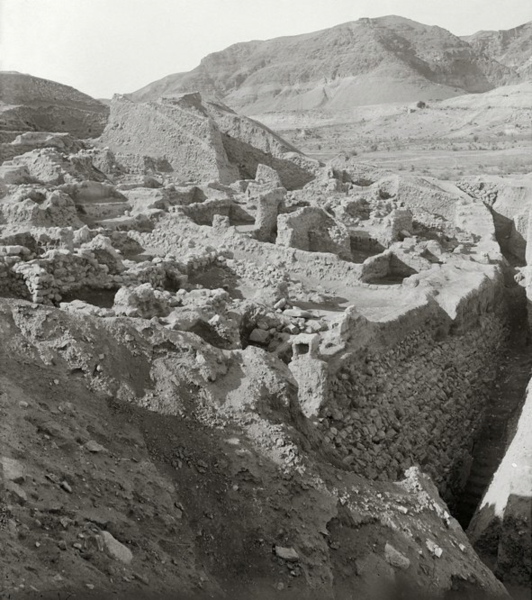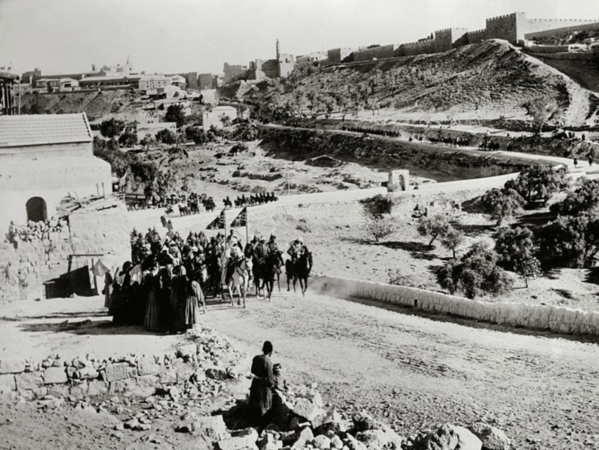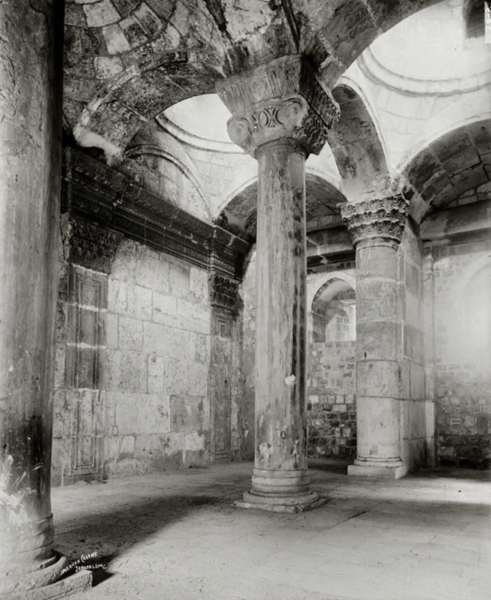The Value of the Collection
by Todd Bolen
Perhaps the photographers of the American Colony had some sense of the massive changes coming to the Holy Land. They witnessed, after all, the first visit of a European head of state to Palestine since the Crusades (1898), and they saw the fall of the Ottoman Empire and the transfer of governorship to the British (1917). The automobile arrived not long after its invention, and the construction of a network of roads began. The photographers themselves were foreigners, and they saw increasing interest among Westerners in visiting and living in the Holy Land. The Spafford family, founders of the American Colony, moved to Palestine the same year as the First Aliyah (1881), and their dreams of seeing many Jews return to the land began to be fulfilled. Perhaps, then, the photographers of this collection had some understanding that their work would document a land and its peoples for a future time when the ancient ways would be lost to change.
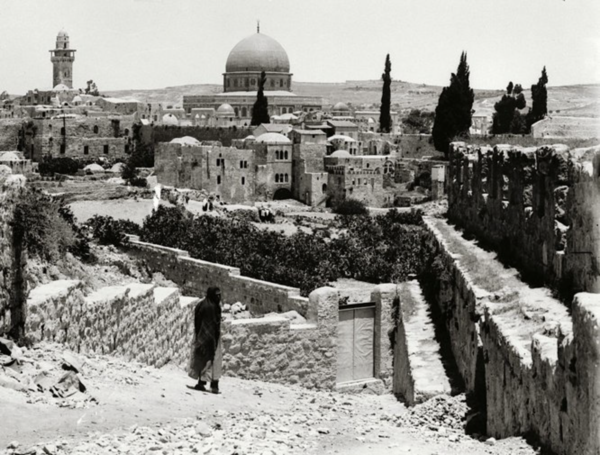
Temple Mount and Western Wall area from southwest
The photographers certainly had a more immediate goal — to sell pictures to visiting tourists. In addition, their photographs were published in newspapers, magazines, and books around the world. The images told stories with great meaning to their contemporaries. In their day, many would never be able to make the long and expensive voyage to the Holy Land, and thus the photographs served as a substitute for a visit. In our day, travel is more affordable and much faster, and many are able to make a pilgrimage or study trip. Thus photographs like these no longer serve the same function as they did originally. Instead of transporting the viewer geographically, today these photographs transport the viewer chronologically.
A chief value of this photograph collection is that it allows us to revisit the land and its people the way they used to be. We can go back, through the lens of the photographer, to sites before they were excavated, panoramas before they were polluted, villages before they were urbanized, and people before they abandoned the way of life of their fathers. More than that, in many photographs we can witness the history that transformed the land, its government, and its inhabitants. With a continual presence in Jerusalem from the late 1800s, the American Colony photographers witnessed many important historical events and personages throughout the subsequent five decades. Their work is a splendid visual record that today gives us insights that the contemporary eyewitnesses might never have thought to commit to writing.
Recreation of feast in fields of Bethlehem, such as described in the book of Ruth
This particular collection, drawn from the larger Matson archive at the Library of Congress, has a decidedly educational purpose. The images selected and the format used is aimed particularly at teachers and students who want to dig deeper into the history of Bible lands. It is directed toward those unsatisfied with modern photographs or videos, or even their own visits. It is for those who ask when and how and why. The photographs don’t provide all of the answers, and indeed, they raise new questions. Photographs, even those unaltered by Photoshop or its primitive predecessors, are not necessarily unbiased. The photographers had commercial interests, some of which involved the reenactment of ancient scenes or events. The editor of the present collection has his own biases, and despite his best efforts otherwise, the selection and organization of the photographs here may unfairly emphasize or exclude certain realities of history.
The selection of 4,300 images from a total of 14,000 available was determined by several factors. First, many images were eliminated because they were duplicates or shared similar content with other photos. Second, some images did not fit within the interests of this collection, such as photographs of Uganda and Kenya. Third, some images were not deemed to be of significant value to a modern audience, such as black and white photographs of flora and fauna. Fourth, some images were too poorly preserved to be of use. Fifth, after much effort, some of them could not be correctly identified. Of those that were selected for inclusion, the intention has been to present them without regard for any political or scholarly agenda. Ideally, we believe that our selection and presentation closely reflects the larger collection as a whole, preserving any biases that were present in the original photographers and those who organized their work. In short, our goal has been perpetuation of the most useful images for understanding the ancient world and recent historical events of import.
Specifically, what are the contributions that this collection makes for us today? We cannot always know what will impress others, but these are some of the reasons that motivated us initially to begin what turned out to be a five–year project and that continue to convince us of its value today.
We love the photographs of the land before modern alterations. . .
Excavations of northern end of Jericho (Tell es-Sultan) from east
- Biblical sites as they looked when first discovered, prior to excavation and reconstruction. Examples of these are Caesarea Philippi, Chorazin, Capernaum, Beth Shean, Robinson’s Arch, Gadara, Gerasa, and the Amman acropolis.
- Ancient cities which were excavated early in the 20th century but the ruins are not well preserved today. Jericho is an outstanding example.
- Important sites that are inaccessible to most visitors today, including Samaria and the Shechem area, Upper and Lower Beth Horon, Hebron (including the “oak of Abraham” and “pool of David”), and the library of St. Catherine’s Monastery.
- Biblical locations that have been “improved” in modern times, such as Ein Harod, where Gideon chose his men, and the Jordan River, which is dammed and no longer floods annually.
- Sites that are now covered by churches or mosques, such as Jacob’s Well, Tabgha, the summit of Mount Tabor, and the Pool of Siloam.
- Landscape now covered with cities, such as the area of Shechem, the slopes of Mount Carmel, Tiberias, Nazareth, the area of the shepherds fields in Bethlehem, and the City of David in Jerusalem.
- Landscape now obscured with trees, shrubbery, and parks, such as Aphek (Antipatris) and Shiloh.
- Historic sites that have experienced major alterations, such as Beth Guvrin, Masada, and Philae Island, before it was completely submerged and the temple moved.
- Oases in the Sinai that are today identified with stops of the Israelites in the wilderness, such as Ayun Musa (Marah?), Wadi Gharandel (Elim?), and Wadi Feiran (Rephidim, Massah, Meribah?).
- Panoramic views with crystal-clear air. With today’s pollution, such views are rare. For example: Mt. Hermon from the Sea of Galilee; the western Galilee coast from Mt. Carmel, including the mountains of Lebanon; the wilderness, Dead Sea, and mountains of Transjordan from Jerusalem; the Bekaa Valley from Mount Hermon; and the Dead Sea and Judean wilderness from Mount Nebo.
- Aerial photographs of the pyramids of Giza, the Nile River, Jerusalem, the Jordan River, and Sidon.
We love the photographs of the traditional way of life. . .
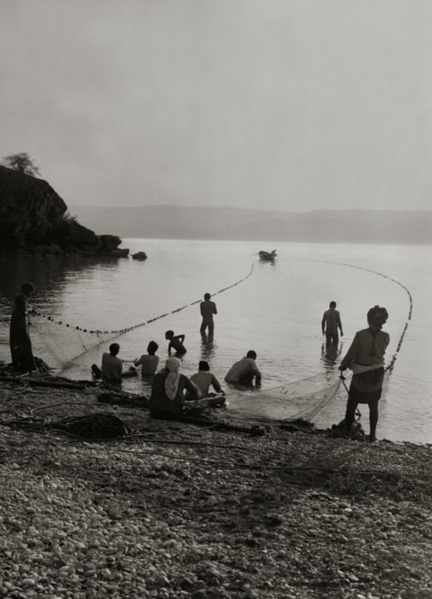
Fishermen drawing in dragnet on Sea of Galilee
- The ancient practices of shepherds, homemakers, potters, fishermen, weavers, carpenters, and merchants.
- Traditional celebrations by religious Christians, Druze, Jews, Muslims, and Samaritans.
- The agricultural cycle, including the festive times of wheat harvest and grape pressing. The complete cycle of the grain harvest is documented, from plowing and sowing, to gathering, threshing, winnowing, and sifting, to the feast that followed.
- A special emphasis on women and their daily activities, including home life, food preparation, and transportation of materials.
- The centrality of water in life, including springs, wells, and the use of the shaduf to draw water from the Nile.
- Ancient villages now no longer inhabited, such as Magdala and En Dor.
- Reenactment scenes of biblical stories, such as Ruth and Boaz, the Christmas story, and Psalm 23.
- Ceremonies as they were practiced by the native peoples for hundreds of years, including weddings and sacrifices.
- Travel as it was in antiquity, with camel caravans crossing the desert.
- A special presentation of locust invasions in the land of Palestine, narrated with a first-hand report that originally appeared in National Geographic magazine in 1915.
We love the photographs of world-changing history unfolding. . .
Visit of Kaiser Wilhelm II to Jerusalem, 1898
- Historic events that have changed the character of the land, such as the visit of German Kaiser Wilhelm II in 1898, the Turkish surrender to the British in 1917, and the earthquake of 1927.
- The city of Jerusalem under Turkish rule, including the presence of soldiers and the camel corps.
- The founding of early Zionist settlements, such as Kibbutz Ein Gev on the eastern shore of the Sea of Galilee, with its tower and stockade.
- Historic visits to Palestine by Field Marshal Edmund Allenby, Lawrence of Arabia, Winston Churchill, and Lord Balfour.
- The city of Jerusalem under British rule, including photographs of Mandatory administrators Herbert Samuel and Edward Keith-Roach.
- The dedication of Hebrew University on April 1, 1925.
- Various Arab leaders including Emir Abdullah, King Faisal of Iraq, King Hussein of Jordan, King Farouk of Egypt, Sultan el-Atrash, and Haj Amin al-Husseini.
- Critical moments in the modern Arab-Israeli conflict, including the riots of 1920 and 1929, the Arab protest of the opening of Hebrew University, the Shaw Commission of Inquiry in 1929, the Jewish response to the White Paper of 1939, and the Jewish bombing of the King David Hotel in 1946.
We love the photographs of so many things that we’ve heard about, but not seen. . .
Interior of Golden Gate, Jerusalem
- Extraordinary, rare photographs inside the Golden Gate, Solomon’s Stables, the Double Gate, Barclay’s Gate, and the Dome of the Rock.
- Historic archaeological excavations in process, such as Tell Beit Mirsim under William F. Albright, Tell Beth Shemesh under Elihu Grant, Hazor under John Garstang, Mizpah (Tell en-Nasbeh) under William F. Badè, Bethel (Beitin) under James Leslie Kelso, Tell el-Farah South under W. M. Flinders Petrie, and the City of David under Raymond Weill and later J. W. Crowfoot and G. M. Fitzgerald.
- Visitors arriving in Palestine by boat at Jaffa, before there was an airport. Various bridges and ferry boats across the Jordan River.
- Solomon’s Pools when they were still in use for water distribution.
- The Dead Sea with a high water level, as well as commercial activity on and around the lake.
- Modern cities in their infancy, such as Tel Aviv, Ramallah, and the new city of Jerusalem.
- The Western (Wailing) Wall before the demolition of the Mughrabi Quarter for the prayer plaza.
- Crusader decorative lintels at the entrance of the Church of the Holy Sepulcher.
- The Dung Gate when it was only a pedestrian path.
- The great synagogues of the Jewish Quarter before their destruction in the 1948 war.
Order this collection here.
You may also be interested in:



